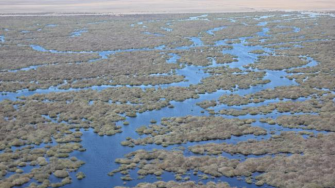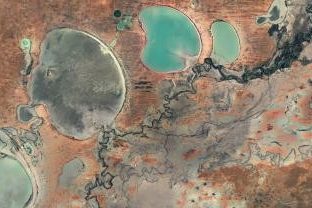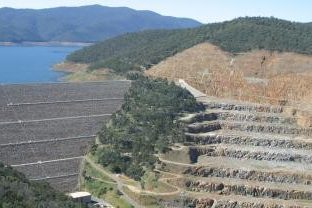
The Gayini wetland is part of the Lowbidgee floodplain, the largest remaining area of wetlands in the Murrumbidgee Valley, with Yanga National Park, within the southern Murray-Darling Basin. This is an amazing part of the world.
We're collaborating on one of the largest restoration projects in the Murray-Darling Basin, which aims to integrate social, cultural and environmental values. The management of environmental flows and large wetlands in the Murray-Darling Basin has been challenging with concerns about disenfranchisement of communities and different management approaches at the local scale, which reflect obligations and interests of state, Commonwealth and non-government organisations. This project builds on the historic opportunity to develop an innovative approach to the land, water and cultural management of the Gayini wetlands with a consortium led by the traditional owners of the Nari Nari Tribal Council and involving The Nature Conservancy and the Murray Wetlands Working Group.
This floodplain and its associated wetlands systems are areas of national and international significance. They provide habitat, breeding grounds for colonial waterbird and other waterbird species, including migratory species listed under international agreements, rare and endangered frogs and birds, as well as threatened plants.
The key vegetation communities identified on Nimmie-Caira include:
- Lignum shrublands
- River Red Gum forests and woodlands
- Black Box woodlands
- mid-floodplain shrublands (inundation tolerant)
- high floodplain shrublands
- Aeolian rise shrublands and woodlands
- Marshes and sedgelands.
Hydrological features include natural river and creek channels, natural quaternary lakes (deflation basins) and irrigation channels. Although some of these features are man-made and have disrupted natural flow regimes, they currently provide critical habitat for wetland biota and in some places, ensure connectivity between dryland areas and the floodplain.
While around half of the property was previously used for cropping and grazing, the majority of it remains covered with significant native vegetation in good or recovering condition.
The natural features of the property are the key to understanding and protecting the cultural values of Nimmie-Caira. Aboriginal people will be back on their own country and designing programs to ensure significant employment and health and wellbeing outcomes.
The natural features will also be a key driver of research and education programs with significant capacity to study and learn from our management activities, involving the Centre for Ecosystem Science.
Cultural values
The entire Nimmie-Caira area was a rich cultural landscape supporting many Aboriginal people, as evidenced by the cultural features, particularly the burial mounds, ovens and sites. There is evidence that Aboriginal people used targeted interventions to promote the productivity of regions like Nimmie-Caira, promoting fish, bird and vegetation growth.
Aboriginal land ownership and management is a key outcome of the consortium bid as evidence has shown that this delivers the best environmental, social and economic outcomes.
All core partners have significant experience building capacity for Aboriginal organisations.
We're able to draw on a strong networks of advisors we have built to deliver integrated sustainability outcomes and to provide access for peer learning from Aboriginal organisations around the following:
- effective governance
- financing
- land and water management
- monitoring and data management/Knowledge systems
- adaptive planning and evaluation.
Economic values
Nimmie-Caira’s economic values stem from a range of anticipated commercial activities including:
- Sustainable low-impact grazing - We’ll demonstrate exemplary food production in balance with nature through responsible low-impact grazing and, when appropriate, opportunistic cropping. It’s anticipated that responsible low-impact grazing will be the primary driver of income while the property transitions over time to a more balanced nature- and culture-based economy. We propose that at the end of the first ten years, up to 50-70 per cent of the property will be grazed with the balance reserved for conservation.
- Carbon farming - We’ll develop a new carbon sequestration methodology to generate verified Australian Carbon Credit Units, able to be traded through the Emissions Reduction Fund.
- Education - We’ll establish the Nimmie-Caira Centre for Two-Way Learning in partnership with a leading university to share traditional ecological knowledge and western science, bridge Indigenous and non-Indigenous cultures and generate income from course participation and visitation.
- Ecotourism - We’ll build a world-class environmental and cultural visitor experience catering for private guests as well as volunteer and educational groups.
- Biodiversity credits - Biodiversity payments will be investigated.
A number of other non-commercial activities are also anticipated including:
- Leverage 20 years’ experience partnering with the Commonwealth Environmental Water Holder and NSW Government to re-establish best practice environmental watering.
- Undertake large scale restoration of lignum, River Red Gum, Black Box and other wetland ecological communities.
- Cultural heritage site assessment and management to protect and maintain assets.
- Infrastructure upgrades and maintenance to enable grazing activities and protect and maintain cultural and environmental assets.
- On ground land management – fire, weeds, pest animals, salinity and threatened species - to protect and maintain assets.
- On ground water management.
- Monitoring and evaluation.
- Increased legal protection of environmental and cultural assets through options that may include declaration of an Indigenous Protected Area, negotiation of in perpetuity protection agreements and/or nomination for listing as a Ramsar site under The Convention on Wetlands of International Importance.
The future management of the property will focus on three main areas of equal importance:
- Environmental protection - Proceeds of the commercial activities will be reinvested into environmental works on Nimmie-Caira. Important natural habitats on the property including extensive wetlands and River Red Gum forests will be enhanced and protected. This includes habitats for threatened animals and plants like the Australasian Bittern, Australian Painted-snipe, Southern Bell Frog and Mossgiel Daisy.
- Indigenous engagement and participation – The property’s Traditional Owners, Nari Nari Tribal Council, will be engaged in the management of the property, providing outstanding opportunities for Indigenous employment, improved health, education and reconnection to country.
- Sustainable development - A diversified range of commercial activities that will boost the local economy and provide ongoing employment in the region around Balranald, NSW. These activities will include sustainable, low impact grazing and tourism as well as other potential activities like carbon farming on parts of the property previously used for agriculture.




